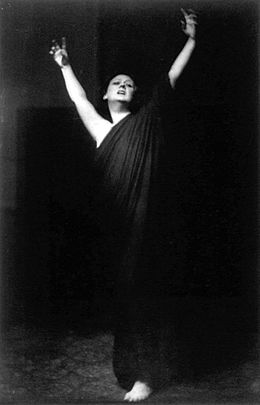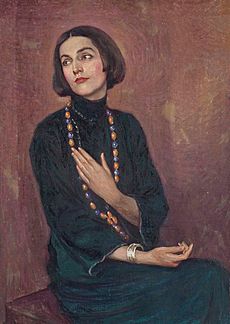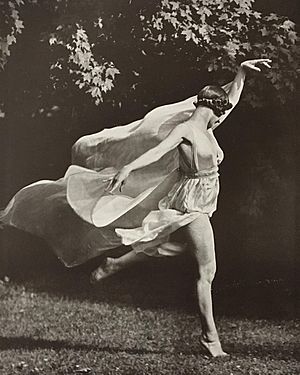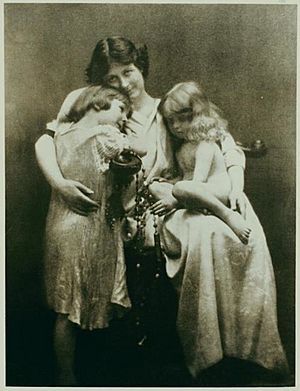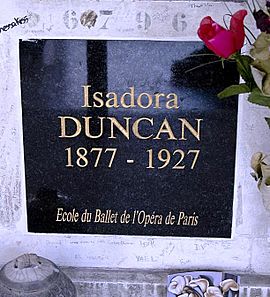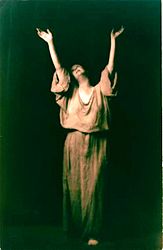Isadora Duncan facts for kids
Quick facts for kids
Isadora Duncan
|
|
|---|---|
 |
|
| Born |
Angela Isadora Duncan
May 26, 1877 San Francisco, California, U.S.
|
| Died | September 14, 1927 (aged 50) Nice, France
|
| Nationality | American, French, Soviet |
| Known for | Dance and choreography |
| Movement | Modern/contemporary dance |
| Spouse(s) | |
| Partner(s) | Edward Gordon Craig Paris Singer Romano Romanelli Mercedes de Acosta |
Angela Isadora Duncan (born May 26, 1877 – died September 14, 1927) was an American dancer. She was a pioneer of modern dance. Isadora performed with great success in Europe and the United States.
Born and raised in California, she lived and danced in many places. These included Western Europe, the US, and the Soviet Union. She did this from age 22 until her death at age 50. Her life ended tragically when her scarf got caught in the wheel of a car. This happened in Nice, France.
Contents
Early Life
Isadora Duncan was born in San Francisco. She was the youngest of four children. Her father, Joseph Charles Duncan, was a banker and mining engineer. Her mother was Mary Isadora Gray. Isadora's brothers were Augustin Duncan and Raymond Duncan. Her sister, Elizabeth Duncan, was also a dancer.
Soon after Isadora was born, her father faced financial problems. He had used money from banks for his own investments. Isadora's mother divorced him because of this and other issues. After the divorce, the family became very poor. Joseph Duncan later died in 1898 when his ship, the SS Mohegan, sank off the coast of Cornwall.
After her parents' divorce, Isadora's mother moved the family to Oakland, California. She worked as a seamstress and piano teacher. Isadora went to school from ages six to ten. But she found school too strict and left. She and her three siblings earned money by teaching dance to local children.
In 1896, Duncan joined Augustin Daly's theater company in New York. However, she soon felt unhappy with traditional theater. She wanted a different way to express herself through dance.
Her Work and Dance Style
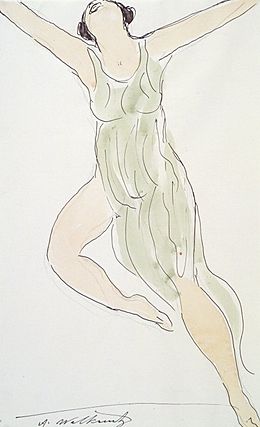
Isadora Duncan's new way of dancing was clear from her teenage years. She would "follow her imagination and create dances on the spot." She taught whatever beautiful movements came to her mind. She wanted to travel, so she went to Chicago. There, she joined Augustin Daly's company. This led her to New York City. But her unique dance ideas did not fit with the popular theater shows of the time.
Feeling unhappy in America, Duncan moved to London in 1898. She performed in the homes of wealthy people. She found inspiration from ancient Greek art, like vases and sculptures, at the British Museum. The money she earned helped her rent a studio. This allowed her to develop her dance and create bigger shows. From London, she traveled to Paris. There, she was inspired by the Louvre museum and the World's Fair of 1900. In France, like elsewhere, Duncan captivated her audiences.
In 1902, another dancer named Loie Fuller invited Duncan to tour with her. This tour took Duncan across Europe. She created new dances using her special technique. This technique focused on natural movement, unlike the strict rules of traditional ballet. She spent most of her life touring Europe and the Americas. Even though critics had mixed reactions, Duncan became very popular. Her unique style inspired many artists. These included sculptors and painters like Antoine Bourdelle and Abraham Walkowitz.
In 1911, the French fashion designer Paul Poiret hosted a grand party. Isadora Duncan, wearing a Greek-style dress, danced on tables. This event was a re-creation of a famous party from the time of Louis XIV.
Starting Dance Schools
Duncan did not like the business side of performing. She felt that touring and contracts took her away from her true goal. Her goal was to create beauty and teach young people. To do this, she opened schools to teach young women her dance ideas. The first school opened in 1904 in Berlin, Germany.
This school was where the "Isadorables" were trained. These were Anna, Maria-Theresa, Irma, Liesel, Gretel, and Erika. They were Duncan's students who would carry on her dance legacy. Duncan adopted all six girls in 1919, and they took her last name. After about ten years in Berlin, Duncan opened a school in Paris. But it soon closed because World War I began.
In 1914, Duncan moved to the United States and brought her school there. A house in Gramercy Park was used for the school. Its studio was nearby. Otto Hermann Kahn, a wealthy banker, let Duncan use the modern Century Theatre for her shows. During her time in New York, Duncan posed for photos by Arnold Genthe.
Duncan had planned to leave the United States in 1915 on the ship RMS Lusitania. But she chose a cheaper trip instead. The Lusitania later sank. In 1921, Duncan's interest in social change led her to the Soviet Union. There, she started a school in Moscow. However, the Soviet government did not keep its promises to support her work. So, she returned to the West and left the school to her student Irma. In 1924, Duncan created a dance called Varshavianka. It was set to a Polish revolutionary song.
Dance Philosophy and Technique
Isadora Duncan broke away from traditional dance. She believed dance was a sacred art form. She created a style of free and natural movements. These were inspired by ancient Greek art, folk dances, and nature. She also included American athletic movements like skipping, running, jumping, and leaping. Duncan wrote about American dancing: "let them come forth with great strides, leaps and bounds, with lifted forehead and far-spread arms, to dance." She focused on natural steps, unlike the strict rules of ballet.
Duncan also said the sea was an early inspiration for her movements. She believed that all movement came from the solar plexus (the center of the body). Duncan emphasized "evolutionary" dance. This meant that each movement grew naturally from the one before it. This new way of thinking about dance earned Duncan the title of the creator of modern dance.
Duncan's dance ideas moved away from strict ballet technique. She aimed for what she saw as natural movement. She wanted to bring dance back to a high art form, not just entertainment. She worked to connect emotions and movement. She said, "I spent long days and nights in the studio seeking that dance which might be the divine expression of the human spirit through the medium of the body's movement." She believed dance should show all of life's feelings, both joy and sadness.
Duncan found inspiration in ancient Greece. She combined this with a love for freedom of movement. This was clear in her revolutionary costume: a simple white Greek tunic and bare feet. These tunics allowed her to move freely, unlike the tight costumes and pointe shoes of ballet. She also used forms from ancient Greek art in her movements.
Personal Life
Isadora Duncan often went against traditional ideas in her personal and professional life.
Her Children
Duncan had three children. Her first two children, Deirdre Beatrice (born 1906) and Patrick Augustus (born 1910), tragically drowned in 1913. This happened when their car rolled into the River Seine while they were with their nanny. After this terrible accident, Duncan spent several months recovering.
In her autobiography, Duncan wrote about her deep sadness after losing her children. She later became pregnant and gave birth to a son in 1914, but he died shortly after birth.

Relationships
Duncan was a loving person. She was very close to her mother, siblings, and friends. In 1921, after the Russian Revolution, Duncan moved to Moscow. There, she met the poet Sergei Yesenin, who was eighteen years younger than her. They married on May 2, 1922. Yesenin traveled with her on a tour of Europe and the United States. However, their marriage was short. They grew apart as they got to know each other. In May 1923, Yesenin returned to Moscow. He died two years later in 1925.
Duncan also had a close friendship with the poet and playwright Mercedes de Acosta. They wrote many letters to each other. In one letter, Duncan wrote, "Mercedes, lead me with your little strong hands and I will follow you – to the top of a mountain. To the end of the world. Wherever you wish."
Later Years
By the late 1920s, Duncan was very sad because of the deaths of her three young children. Her performing career became less active. She also felt she had lost some of her adopted students, the "Isadorables," to older men they met while touring. She spent her final years moving between Paris and the Mediterranean. She built up debts at hotels. Friends and supporters helped her by renting apartments for her. Many also tried to help her write her autobiography. They hoped it would be successful enough to support her. Her autobiography, My Life, was published in 1927, shortly after her death. The composer Percy Grainger called it a "life-enriching masterpiece."
In his book Isadora, An Intimate Portrait, Sewell Stokes described Duncan's wild and free spirit. He met her in her last years.
Death
On the night of September 14, 1927, in Nice, France, Duncan was riding in an Amilcar CGSS car. It was owned by Benoît Falchetto, a mechanic. She was wearing a long, flowing, hand-painted silk scarf. It was a gift from her friend Mary Desti. Desti had asked her to wear a cape because of the cold. But Duncan only agreed to wear the scarf.
As they left, she reportedly said to her friends, "Adieu, mes amis. Je vais à la gloire !" ("Farewell, my friends. I go to glory!"). However, according to the novelist Glenway Wescott, Desti later said Duncan's actual words were, "Je vais à l'amour" ("I am off to love").
The New York Times reported that Duncan "met a tragic death at Nice on the Riviera". The accident happened when her scarf became tangled in the car's wheel. At the time of her death, Duncan was a citizen of the Soviet Union.
Duncan was cremated. Her ashes were placed next to those of her children. This was in the columbarium at Père Lachaise Cemetery in Paris. On her grave's headstone, it says École du Ballet de l'Opéra de Paris ("Ballet School of the Opera of Paris").
Works
- Duncan, Isadora (1927) "My Life" New York City: Boni & Liveright
- Duncan, Isadora; Cheney, Sheldon (ed.) The Art of the Dance. New York: Theater Arts, 1928. ISBN: 0-87830-005-8
Legacy
Isadora Duncan is known as "The Mother of Dance." While her schools in Europe did not last long, her work had a big impact on dance. Her style is still performed today. This is thanks to the teaching of Maria-Theresa Duncan, Anna Duncan, and Irma Duncan. These were three of her six adopted daughters. All six of Isadora's dancers changed their last name to Duncan. Through her sister, Elizabeth, Duncan's ideas were also adopted by Jarmila Jeřábková in Prague.
By 1913, she was already famous. When the Théâtre des Champs-Élysées was built, Duncan's image was carved into the stone above the entrance. This was done by sculptor Antoine Bourdelle. She was also included in paintings of the nine muses in the auditorium. In 1987, she was added to the National Museum of Dance and Hall of Fame.
Anna, Lisa, Theresa, and Irma were students from Isadora Duncan's first school. They continued her dance ideas and teaching methods in New York and Paris. Dancer and choreographer Julia Levien also helped spread Duncan's work. She formed the Duncan Dance Guild in the 1950s. She also created the Duncan Centenary Company in 1977.
Another way Duncan's dance techniques were kept alive was through the Isadora Duncan Heritage Society. This was founded by Mignon Garland. Garland had learned dance from two of Duncan's main students. Garland later lived in a building at the same address as Duncan. She placed a special plaque near the entrance, which is still there as of 2016[update]. Garland also helped rename an alley in San Francisco to Isadora Duncan Lane.
In medicine, the Isadora Duncan Syndrome refers to an injury or death. This happens when neckwear gets caught in a wheel or other machinery.
Photo gallery
- Photographic studies of Isadora Duncan made in New York by Arnold Genthe during her visits to America in 1915–1918
See also
 In Spanish: Isadora Duncan para niños
In Spanish: Isadora Duncan para niños
- List of dancers
- Women in dance
- Dancer in a café
- Isidora, sometimes spelled Isadora


